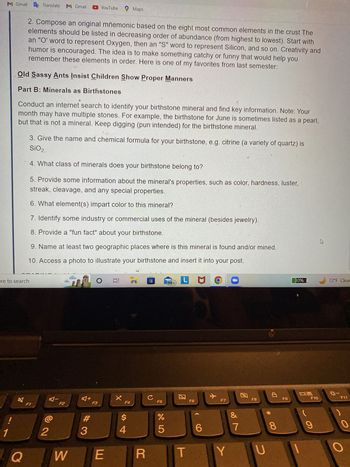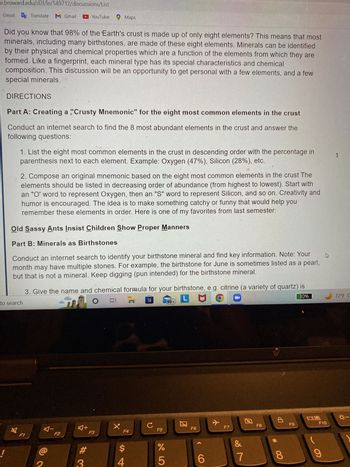
Applications and Investigations in Earth Science (9th Edition)
9th Edition
ISBN: 9780134746241
Author: Edward J. Tarbuck, Frederick K. Lutgens, Dennis G. Tasa
Publisher: PEARSON
expand_more
expand_more
format_list_bulleted
Question

Transcribed Image Text:M Gmail
!
ere to search
1
2. Compose an original mnemonic based on the eight most common elements in the crust The
elements should be listed in decreasing order of abundance (from highest to lowest). Start with
an "O' word to represent Oxygen, then an "S" word to represent Silicon, and so on. Creativity and
humor is encouraged. The idea is to make something catchy or funny that would help you
remember these elements in order. Here is one of my favorites from last semester:
Old Sassy Ants Insist Children Show Proper Manners
Part B: Minerals as Birthstones
Translate M Gmail
Conduct an internet search to identify your birthstone mineral and find key information. Note: Your
month may have multiple stones. For example, the birthstone for June is sometimes listed as a pearl,
but that is not a mineral. Keep digging (pun intended) for the birthstone mineral.
Q
3. Give the name and chemical formula for your birthstone, e.g. citrine (a variety of quartz) is
SiO₂.
4. What class of minerals does your birthstone belong to?
F1
5. Provide some information about the mineral's properties, such as color, hardness, luster,
streak, cleavage, and any special properties.
6. What element(s) impart color to this mineral?
7. Identify some industry or commercial uses of the mineral (besides jewelry).
8. Provide a "fun fact" about your birthstone.
9. Name at least two geographic places where is this mineral is found and/or mined.
10. Access a photo to illustrate your birthstone and insert it into your post.
LMO
5
A-
YouTube Maps
2
F2
#3
F3
O 81 7
F4
$
4
*4
E
W
R
с
F5
%
5
99+
T
F6
6
Y
F7
Y
&
7
F8
U
8
F9
30%
09
F10
9
72°F Clear
0:-
F11

Transcribed Image Text:e.broward.edu/d2l/le/549712/discussions/List
Gmail Translate M Gmail
Did you know that 98% of the Earth's crust is made up of only eight elements? This means that most
minerals, including many birthstones, are made of these eight elements. Minerals can be identified
by their physical and chemical properties which are a function of the elements from which they are
formed. Like a fingerprint, each mineral type has its special characteristics and chemical
composition. This discussion will be an opportunity to get personal with a few elements, and a few
special minerals.
DIRECTIONS
Part A: Creating a "Crusty Mnemonic" for the eight most common elements in the crust
Conduct an internet search to find the 8 most abundant elements in the crust and answer the
following questions:
1. List the eight most common elements in the crust in descending order with the percentage in
parenthesis next to each element. Example: Oxygen (47%), Silicon (28%), etc.
2. Compose an original mnemonic based on the eight most common elements in the crust The
elements should be listed in decreasing order of abundance (from highest to lowest). Start with
an "O' word to represent Oxygen, then an "S" word to represent Silicon, and so on. Creativity and
humor is encouraged. The idea is to make something catchy or funny that would help you
remember these elements in order. Here is one of my favorites from last semester:
Old Sassy Ants Insist Children Show Proper Manners
Part B: Minerals as Birthstones
Conduct an internet search to identify your birthstone mineral and find key information. Note: Your
month may have multiple stones. For example, the birthstone for June is sometimes listed as a pearl,
but that is not a mineral. Keep digging (pun intended) for the birthstone mineral.
3. Give the name and chemical formula for your birthstone, e.g. citrine (a variety of quartz) is
O
81 77
PM
30%
to search
YouTube Maps
F1
@
F2
A+
# 3
F3
X
F4
$
4
с
F5
%
5
99+
团
F6
6
+
F7
N
&
7
F8
8
F9
4
F10
9
1
72°F C
☀-
Expert Solution
This question has been solved!
Explore an expertly crafted, step-by-step solution for a thorough understanding of key concepts.
This is a popular solution
Trending nowThis is a popular solution!
Step by stepSolved in 2 steps

Knowledge Booster
Recommended textbooks for you
 Applications and Investigations in Earth Science ...Earth ScienceISBN:9780134746241Author:Edward J. Tarbuck, Frederick K. Lutgens, Dennis G. TasaPublisher:PEARSON
Applications and Investigations in Earth Science ...Earth ScienceISBN:9780134746241Author:Edward J. Tarbuck, Frederick K. Lutgens, Dennis G. TasaPublisher:PEARSON Exercises for Weather & Climate (9th Edition)Earth ScienceISBN:9780134041360Author:Greg CarbonePublisher:PEARSON
Exercises for Weather & Climate (9th Edition)Earth ScienceISBN:9780134041360Author:Greg CarbonePublisher:PEARSON Environmental ScienceEarth ScienceISBN:9781260153125Author:William P Cunningham Prof., Mary Ann Cunningham ProfessorPublisher:McGraw-Hill Education
Environmental ScienceEarth ScienceISBN:9781260153125Author:William P Cunningham Prof., Mary Ann Cunningham ProfessorPublisher:McGraw-Hill Education Earth Science (15th Edition)Earth ScienceISBN:9780134543536Author:Edward J. Tarbuck, Frederick K. Lutgens, Dennis G. TasaPublisher:PEARSON
Earth Science (15th Edition)Earth ScienceISBN:9780134543536Author:Edward J. Tarbuck, Frederick K. Lutgens, Dennis G. TasaPublisher:PEARSON Environmental Science (MindTap Course List)Earth ScienceISBN:9781337569613Author:G. Tyler Miller, Scott SpoolmanPublisher:Cengage Learning
Environmental Science (MindTap Course List)Earth ScienceISBN:9781337569613Author:G. Tyler Miller, Scott SpoolmanPublisher:Cengage Learning Physical GeologyEarth ScienceISBN:9781259916823Author:Plummer, Charles C., CARLSON, Diane H., Hammersley, LisaPublisher:Mcgraw-hill Education,
Physical GeologyEarth ScienceISBN:9781259916823Author:Plummer, Charles C., CARLSON, Diane H., Hammersley, LisaPublisher:Mcgraw-hill Education,

Applications and Investigations in Earth Science ...
Earth Science
ISBN:9780134746241
Author:Edward J. Tarbuck, Frederick K. Lutgens, Dennis G. Tasa
Publisher:PEARSON

Exercises for Weather & Climate (9th Edition)
Earth Science
ISBN:9780134041360
Author:Greg Carbone
Publisher:PEARSON

Environmental Science
Earth Science
ISBN:9781260153125
Author:William P Cunningham Prof., Mary Ann Cunningham Professor
Publisher:McGraw-Hill Education

Earth Science (15th Edition)
Earth Science
ISBN:9780134543536
Author:Edward J. Tarbuck, Frederick K. Lutgens, Dennis G. Tasa
Publisher:PEARSON

Environmental Science (MindTap Course List)
Earth Science
ISBN:9781337569613
Author:G. Tyler Miller, Scott Spoolman
Publisher:Cengage Learning

Physical Geology
Earth Science
ISBN:9781259916823
Author:Plummer, Charles C., CARLSON, Diane H., Hammersley, Lisa
Publisher:Mcgraw-hill Education,